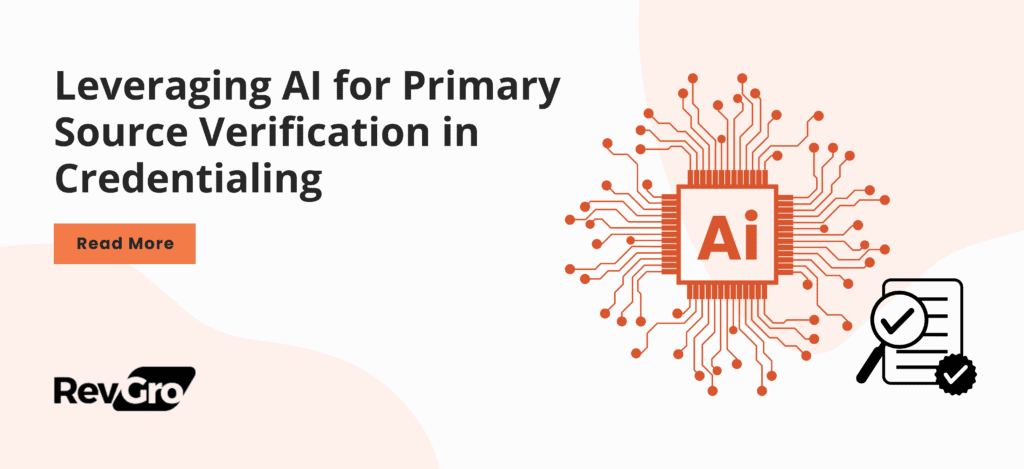
- Introduction: The Role of Primary Source Verification in Credentialing
- The Emergence of AI in Healthcare Credentialing
- Enhancing Accuracy Through AI-Powered Verification.
- Improving Efficiency with Automationg
- Challenges and Considerations in Implementing AI for Credentialing
- Future Outlook: AI's Role in Shaping Credentialing Practices
Leveraging AI for Primary Source Verification in Credentialing
A recent survey by the American Medical Association found that nearly two-thirds of physicians see advantages to using AI in healthcare, with many anticipating that it will reduce documentation time and administrative burdens.
Credentialing is the backbone of healthcare compliance, ensuring that medical providers meet the necessary qualifications and standards to practice. Primary Source Verification (PSV) is a critical component of credentialing, requiring direct confirmation of a provider’s education, certifications, and work history from original sources such as universities, licensing boards, and employers. However, traditional manual verification is often slow, labor-intensive, and prone to errors, creating bottlenecks in the onboarding process.
Artificial Intelligence (AI) is transforming healthcare credentialing by automating PSV, improving accuracy, and significantly reducing verification timelines. In this blog, we explore how AI enhances primary source verification, improves efficiency, addresses compliance challenges, and shapes the future of credentialing practices.
Primary Source Verification (PSV) is essential for maintaining healthcare quality and safety. It involves validating a provider’s credentials directly from original sources rather than relying on self-reported information or third-party records.
Why PSV Matters in Healthcare Credentialing
- Ensures that healthcare professionals meet legal and regulatory standards.
- Protects patients by verifying the authenticity of provider qualifications.
- Reduces risks associated with fraud or misrepresentation of credentials.
- Helps healthcare organizations maintain compliance with payer and accreditation bodies (e.g., NCQA, CMS, The Joint Commission).
Challenges of Manual Primary Source Verification
- Time-Consuming: Manual PSV can take weeks or even months, delaying provider onboarding.
- Error-Prone: Manual data entry increases the risk of credentialing discrepancies.
- Compliance Risks: Failure to verify credentials accurately can result in penalties, loss of accreditation, or fraud cases.
- Administrative Burden: Healthcare organizations often require dedicated staff for PSV, increasing operational costs.
To overcome these challenges, AI-driven credentialing solutions are now being integrated into PSV workflows, streamlining the entire process.
AI is revolutionizing healthcare credentialing by automating primary source verification and reducing reliance on manual processes. AI-driven solutions improve credential validation accuracy, minimize human intervention, and speed up provider onboarding.
How AI is Transforming the Credentialing Landscape
- Automated Data Retrieval: AI extracts and verifies information from licensing boards, educational institutions, and government registries in real time.
- Predictive Analytics: Machine learning models identify discrepancies and flag potential fraud before issues arise.
- Pattern Recognition: AI detects irregularities in submitted credentials, such as mismatches in employment history or licensing details.
Key Technologies Driving AI-Based Verification
- Optical Character Recognition (OCR): Converts paper-based credentialing documents into digital, searchable data.
- Natural Language Processing (NLP): Reads and interprets unstructured data from different sources, ensuring consistent verification.
- Blockchain Integration: Provides a tamper-proof ledger for credential verification, enhancing security and transparency.
- Robotic Process Automation (RPA): Automates repetitive administrative tasks such as checking databases for license expiration.
By leveraging these technologies, AI-based PSV systems can reduce verification timelines from weeks to just days, significantly improving efficiency.
Credentialing errors can lead to serious consequences, including legal action, claim denials, and compliance violations. AI-powered PSV improves accuracy by minimizing human intervention in error-prone processes.
How AI Reduces Human Errors in Credential Validation
- Automated Cross-Referencing: AI systems compare provider data across multiple sources to detect inconsistencies.
- Real-Time Alerts: AI flags discrepancies immediately, allowing credentialing teams to resolve them proactively.
- Data Standardization: AI ensures uniform formatting and validation, eliminating variations in document structure.
Real-World Example of AI-Related Billing Errors:
The Importance of Human Oversight in RCM
Key Areas Requiring Human Oversight:
- Decision-Making for Complex Cases
- Certain claims require human judgment, such as medical necessity appeals or non-standard billing scenarios.
- AI lacks contextual reasoning; medical billing experts are needed to make informed financial decisions.
- Periodic Audits and Compliance Checks
- AI should not operate unchecked—regular audits can catch inaccuracies before they become legal risks.
- Example: Compliance teams must review AI-generated claims to ensure they align with payer policies and government regulations.
- Ensuring Patient-Centric Billing
- AI-driven billing must be patient-friendly to avoid confusion.
- Billing staff should intervene when AI-driven systems produce unclear or disputed invoices.
Balancing Automation and Oversight for Optimal Results
Best Practices for AI-Driven RCM with Human Oversight:
- Establish AI Governance Policies
- Define roles for AI and human intervention in the RCM workflow.
- Assign AI monitoring teams to track and validate system outputs.
- Implement AI-Driven Auditing Tools
- Use AI for continuous monitoring but integrate human audit checkpoints.
- Example: AI can flag high-risk claims, but human reviewers should validate them before submission.
- Use Explainable AI (XAI) for Transparency
- XAI models provide rationale for AI-driven billing decisions, ensuring transparency.
- Healthcare providers should choose AI vendors that offer audit-friendly AI solutions.
- Train Revenue Cycle Staff in AI Integration
- Ensure RCM professionals understand AI’s capabilities and limitations.
- Cross-train teams to use AI tools effectively without complete dependence.
Key Takeaways:
- AI improves RCM efficiency, accuracy, and revenue optimization.
- Unchecked automation can lead to billing errors, denials, and compliance risks.
- Human oversight is critical for decision-making, audits, and patient-centric billing.
- A hybrid model—leveraging AI while maintaining human intervention—is the ideal approach.
